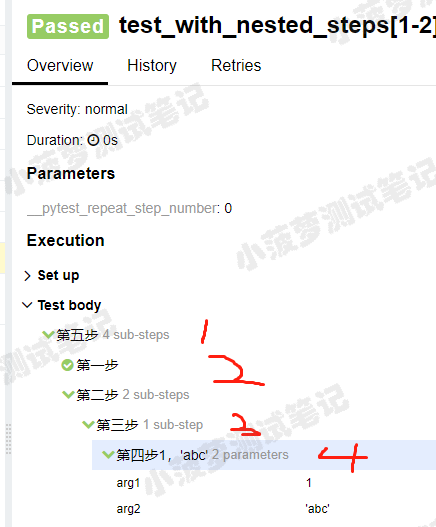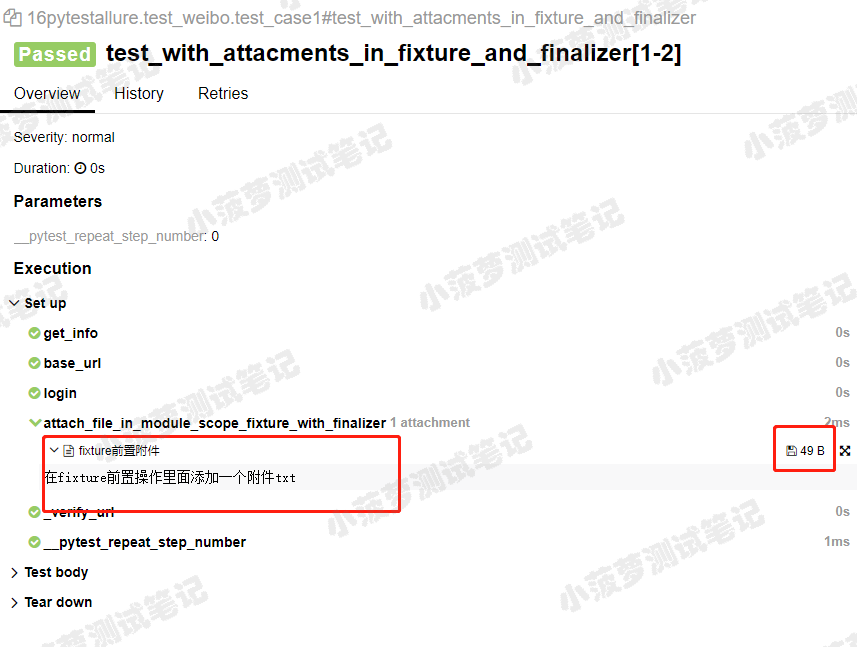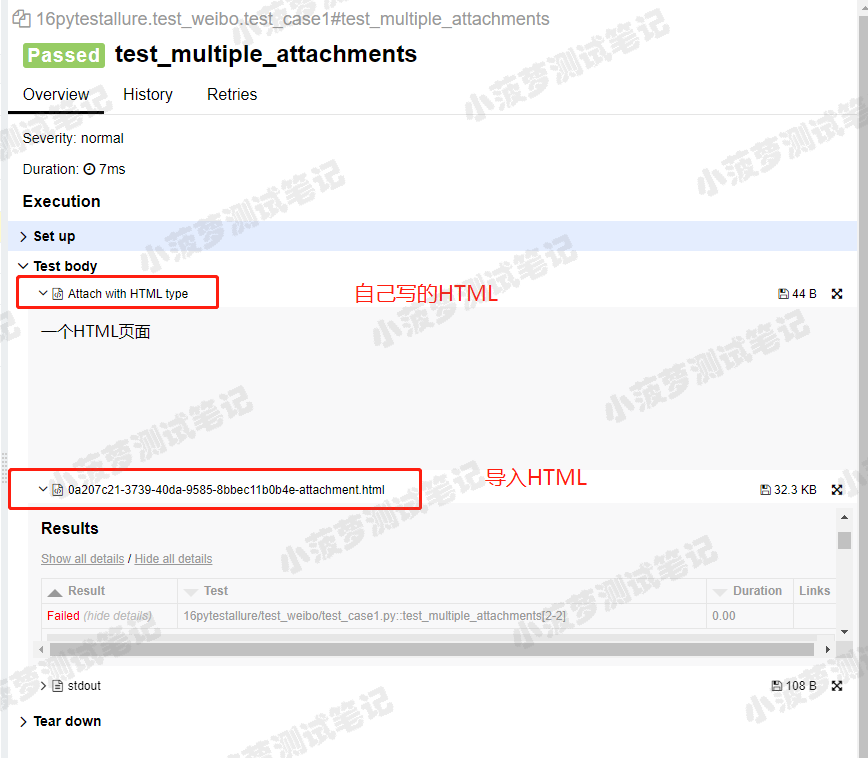Pytest系列(20)- allure的特性,@allure.step()、allure.attach的详细使用
如果你还想从头学起Pytest,可以看看这个系列的文章哦!
https://www.cnblogs.com/poloyy/category/1690628.html
前言
allure除了支持pytest自带的特性之外(fixture、parametrize、xfail、skip),自己本身也有强大的特性可以在pytest中使用
@allure.step
- allure报告最重要的一点是,它允许对每个测试用例进行非常详细的步骤说明
- 通过 @allure.step() 装饰器,可以让测试用例在allure报告中显示更详细的测试过程
示例代码
#!/usr/bin/env python # -*- coding: utf-8 -*- """ __title__ = __Time__ = 2020-04-08 21:24 __Author__ = 小菠萝测试笔记 __Blog__ = https://www.cnblogs.com/poloyy/ """ import allure @allure.step("第一步") def passing_step(): pass @allure.step("第二步") def step_with_nested_steps(): nested_step() @allure.step("第三步") def nested_step(): nested_step_with_arguments(1, 'abc') @allure.step("第四步{0},{arg2}") def nested_step_with_arguments(arg1, arg2): pass @allure.step("第五步") def test_with_nested_steps(): passing_step() step_with_nested_steps()
测试用例在allure上的显示

知识点
- step() 只有一个参数,就是title,你传什么,在allure上就显示什么
- 可以像python字符串一样,支持位置参数和关键字参数 {0},{arg2},可看第四步那里,如果函数的参数没有匹配成功就会报错哦
- step() 的使用场景,给我感觉就是,当方法之间嵌套会比较有用,否则的话只会显示一个步骤,类似下面图

allure.attach(挺有用的)
作用:allure报告还支持显示许多不同类型的附件,可以补充测试结果;自己想输出啥就输出啥,挺好的
语法: allure.attach(body, name, attachment_type, extension)
参数列表
- body:要显示的内容(附件)
- name:附件名字
- attachment_type:附件类型,是 allure.attachment_type 里面的其中一种
- extension:附件的扩展名(比较少用)
allure.attachment_type提供了哪些附件类型?

语法二: allure.attach.file(source, name, attachment_type, extension)
source:文件路径,相当于传一个文件
其他参数和上面的一致
其中一个测试用例的代码栗子
#!/usr/bin/env python # -*- coding: utf-8 -*- """ __title__ = __Time__ = 2020-04-08 21:24 __Author__ = 小菠萝测试笔记 __Blog__ = https://www.cnblogs.com/poloyy/ """ import allure import pytest @pytest.fixture def attach_file_in_module_scope_fixture_with_finalizer(request): allure.attach('在fixture前置操作里面添加一个附件txt', 'fixture前置附件', allure.attachment_type.TEXT) def finalizer_module_scope_fixture(): allure.attach('在fixture后置操作里面添加一个附件txt', 'fixture后置附件', allure.attachment_type.TEXT) request.addfinalizer(finalizer_module_scope_fixture) def test_with_attacments_in_fixture_and_finalizer(attach_file_in_module_scope_fixture_with_finalizer): pass def test_multiple_attachments(): allure.attach('<head></head><body> 一个HTML页面 </body>', 'Attach with HTML type', allure.attachment_type.HTML) allure.attach.file('./reports.html', attachment_type=allure.attachment_type.HTML)
运行之后看结果

这是一个txt附件

这是一个用了 allure.attach() 来插入一段自己写的HTML和 allure.attach.file() 来导入一个已存在的HTML文件(pytest-html报告)




【推荐】国内首个AI IDE,深度理解中文开发场景,立即下载体验Trae
【推荐】编程新体验,更懂你的AI,立即体验豆包MarsCode编程助手
【推荐】抖音旗下AI助手豆包,你的智能百科全书,全免费不限次数
【推荐】轻量又高性能的 SSH 工具 IShell:AI 加持,快人一步
· 从 HTTP 原因短语缺失研究 HTTP/2 和 HTTP/3 的设计差异
· AI与.NET技术实操系列:向量存储与相似性搜索在 .NET 中的实现
· 基于Microsoft.Extensions.AI核心库实现RAG应用
· Linux系列:如何用heaptrack跟踪.NET程序的非托管内存泄露
· 开发者必知的日志记录最佳实践
· winform 绘制太阳,地球,月球 运作规律
· 超详细:普通电脑也行Windows部署deepseek R1训练数据并当服务器共享给他人
· TypeScript + Deepseek 打造卜卦网站:技术与玄学的结合
· AI 智能体引爆开源社区「GitHub 热点速览」
· 写一个简单的SQL生成工具